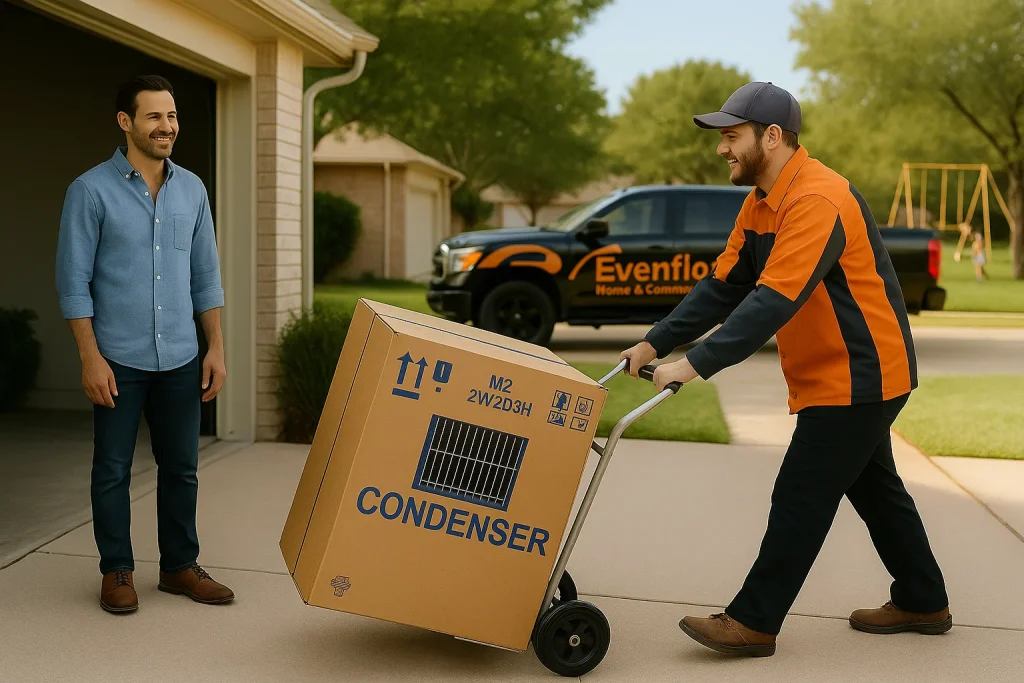When your heating and cooling system starts showing its age, it can be tempting to keep patching things up with quick repairs. While this may buy time in the short term, an older, inefficient HVAC system will continue to cost you more in energy bills, comfort, and ongoing service calls. Older furnaces are generally less efficient, have lower AFUE ratings, and are more prone to frequent repairs compared to newer models. Proper installation and regular maintenance can significantly extend a furnace’s life, while poor installation may shorten the furnace’s life considerably. Most furnaces have a lifespan of 20–30 years, so if your system is nearing the end of its expected life, replacement may be the better option. On average, the cost to replace a furnace, including materials, equipment, and labor, is $4,771. The price range for average furnace replacement costs is typically between $2,825 and $6,846. The total costs of furnace replacement include not just the price of the unit, but also labor, materials, and any necessary upgrades to ductwork or other components. In many cases, replacing the entire system is the smarter and more cost-effective solution, especially if your ductwork also needs attention. Deciding when to replace an old system depends on factors like age, repair frequency, and efficiency. When the system and ductwork are addressed together, the old unit is replaced with a new, more efficient one.

Stop Sinking Money Into Frequent HVAC Repairs
Minor fixes make sense for newer units, but for systems that are 10–15 years old or older, repeated repairs are often just temporary band-aids. Worn-out motors, refrigerant leaks, or failing compressors may keep resurfacing. Strange noises from the furnace may suggest the need for replacement. Each repair not only adds to your expenses but also prolongs the inevitable: full system replacement. Labor costs for HVAC installation can typically range from $500 to $2,000, so it’s important to weigh these expenses against the benefits of a new system. Before making a decision, consult an HVAC professional to assess whether repairs or replacement is the best option for your situation. Investing in a new HVAC system eliminates the cycle of costly breakdowns and provides warranty protection that helps control future repair costs, especially when paired with a complete HVAC installation process tailored for long-term success. When considering a new system, remember that installation costs and the overall installation cost are important factors in the total expense, as they can vary depending on system type, ductwork modifications, and additional materials needed. It is essential to have a qualified professional install the new system to ensure optimal performance and long-term satisfaction.
Furnace Replacement Options
When it comes to furnace replacement, homeowners have a variety of options to suit their specific heating needs and budget. Natural gas furnaces remain a top choice for many, thanks to their high efficiency, reliable performance, and ability to deliver consistent heat even in colder climates. These gas furnaces often feature advanced heat exchanger technology and high annual fuel utilization efficiency (AFUE) ratings, which means more of the fuel you pay for is converted into usable heat, helping you save money on heating bills and reduce overall energy bills.
For those without access to natural gas, electric furnaces offer a clean and flexible alternative. While electric furnaces can have higher operating costs in some regions, they are known for their quiet operation and ease of installation. Oil furnaces are another option, particularly in areas where oil is a more readily available fuel source. Each furnace type comes with its own set of benefits, efficiency levels, and installation requirements.
When selecting a new furnace, it’s important to consider the heating capacity needed for your home’s square footage, the efficiency rating (AFUE), and whether the unit includes features like a second heat exchanger for even greater energy savings. High efficiency furnaces, especially those with a second heat exchanger, can significantly lower your energy bills over time and provide a more comfortable indoor environment.
Consulting with an experienced HVAC professional is the best way to determine which replacement furnace will deliver the right balance of efficiency, cost, and performance for your home. They can help you compare models, fuel types, and features to ensure your new furnace is sized correctly and meets your long-term heating goals.
Furnace Replacement Process
The furnace replacement process begins with a thorough assessment of your current heating system by a qualified HVAC contractor. This evaluation includes inspecting the old furnace, checking the condition of your ductwork, and reviewing your home’s ventilation to identify the most efficient and cost-effective replacement options. The contractor will recommend a new furnace that matches your heating needs, taking into account factors like efficiency, heating capacity, and compatibility with your existing system.
Once you’ve selected the right replacement furnace, the installation process moves forward. The old furnace is carefully removed, and the new unit is installed and connected to your home’s ductwork and ventilation system. Proper installation is essential for achieving optimal performance, energy efficiency, and safety. A reputable HVAC company will ensure that all equipment is installed according to manufacturer specifications and local building codes.
It’s also critical to ensure proper ventilation during installation to prevent the risk of carbon monoxide buildup, a dangerous and potentially deadly gas produced by malfunctioning or improperly vented furnaces. This safety consideration underscores the importance of professional installation and regular maintenance.
Homeowners should also be aware of installation costs, which can vary based on the complexity of the job, the type of furnace being installed, and any necessary repairs or modifications to the heating system. Permits and inspections may be required to ensure the installation meets safety standards. Your HVAC contractor should provide a detailed estimate outlining the total cost, including equipment, labor, and any additional work needed.
After installation, regular maintenance and timely repairs are key to extending the life of your new furnace and preventing frequent repairs. By following the recommended furnace replacement process and working with a trusted HVAC company, you can enjoy efficient, reliable heating and peace of mind for years to come.
Upgrade for Long-Term Energy Savings
One of the biggest advantages of replacement is improved energy efficiency. New heating systems often come with higher AFUE ratings, which means they convert more fuel into usable heat and waste less energy. Older systems often operate at lower Seasonal Energy Efficiency Ratio (SEER2) ratings and become even less efficient as parts wear down. This leads to longer run times and higher utility bills. Improved efficiency in modern systems can significantly reduce heating bills over time. Modern HVAC systems, by contrast, feature advanced technology like variable-speed motors and smart thermostats that optimize energy use. Upgrading your HVAC system can lower monthly energy costs by 20% or more, making a replacement a true long-term investment. Variable-speed blowers contribute to improved efficiency in modern furnaces. Features such as a second heat exchanger and an efficient heat exchanger design further increase AFUE ratings and overall system efficiency. Installation costs can range from $800 to $2,650 depending on modifications and permits needed. Proper installation and regular maintenance are also important to extend the furnace’s life and ensure reliable performance. Other factors, such as the type of heating systems you choose and the quality of installation, also influence the overall value and cost-effectiveness of your investment.
Improve Comfort & Air Quality with Modern HVAC Systems
An aging system doesn’t just hurt your wallet, it also impacts your comfort. Reliable home heating is essential for maintaining a comfortable living environment, especially during colder months.
If you notice uneven temperatures, weak airflow, or excess humidity, it may be a sign your system is struggling. A new HVAC unit delivers steady comfort across your entire home, with better control over temperature and humidity levels. Upgrading to a modern, whole-house HVAC system can significantly improve comfort and air quality throughout the house, enhancing the living environment for all occupants. Investing in newer furnace technology can improve comfort by providing more consistent heat distribution. Upgrading your system can also improve the performance and compatibility of your air conditioner, ensuring efficient heating and cooling throughout the year.
Many newer systems also include improved filtration and air purification, which help reduce dust, allergens, and airborne pollutants. Proper ventilation is also crucial for maintaining healthy indoor air quality and ensuring your system operates safely and efficiently. This makes replacement especially beneficial for families with allergies or respiratory sensitivities.
For optimal comfort and air quality, consider working with a reputable hvac company to handle your system replacement.
Why Your Ductwork Matters During HVAC Replacement
Even the most advanced HVAC system can’t perform well if your ducts are in poor condition. Leaky, undersized, or poorly insulated ducts allow conditioned air to escape before it reaches your rooms, forcing the system to work harder and driving up energy costs. In fact, the U.S. Department of Energy estimates that leaky ducts can waste 20–30% of the air moving through a system. Evaluating duct performance during central A/C system maintenance helps ensure your new HVAC unit achieves peak performance from day one.
When considering a replacement furnace, it’s important to understand the differences between single stage and two stage systems. A single stage furnace operates at full capacity whenever it runs, while a two stage furnace can switch between high and low settings for better energy efficiency and comfort. You can choose from several types of systems, including gas furnace, natural gas furnace, electric furnace, and oil furnace. Electric furnaces can cost between $500 and $7,000 to replace. Common fuel types for furnaces in San Antonio include gas, electric, and heat pumps. Gas furnaces generally have replacement costs ranging from $3,800 to $10,000. Gas furnace replacement cost and overall price ranges will vary depending on the type of replacement furnace you select, with factors like efficiency, fuel source, and installation details all influencing the final cost.
If you’re replacing your HVAC system, it’s the perfect time to evaluate your ductwork. Signs that duct repair or replacement may be needed include:
- Rooms that are consistently hotter or colder than others
- Whistling or rattling noises when the system is running
- Visible damage, sagging, or disconnected ducts
- Excessive dust or poor air quality in the home
Addressing duct issues at the same time as a system replacement ensures that your new unit operates at peak efficiency, maximizes comfort, and helps protect indoor air quality.
Geographic and Climate Considerations
When planning a furnace replacement, it’s important to factor in your region’s climate and the availability of different fuel sources. In colder climates, high efficiency furnaces with a strong Annual Fuel Utilization Efficiency (AFUE) rating are often the best bet for keeping your home warm while minimizing energy use. Natural gas furnaces are a popular choice in many areas because they offer reliable heat and are generally cost effective to operate. However, if natural gas isn’t available in your area, propane furnaces or electric furnaces can be excellent alternatives, each with their own efficiency and installation considerations. Mild winters in San Antonio make it essential to balance the cost of a high-efficiency furnace against actual heating needs. A new mandate will require all new residential gas furnaces to have a fuel efficiency rating of at least 95% AFUE starting in 2028. Furnace replacements require a permit in San Antonio to ensure compliance with safety standards.
The heating capacity of your new furnace should be sized correctly for your home’s square footage and insulation levels to ensure optimal performance and comfort. Furnace replacement cost can vary widely depending on the furnace type, fuel source, and the complexity of the installation. Consulting with a knowledgeable HVAC contractor is essential, they can assess your home’s heating needs, recommend the right high efficiency furnace, and help you understand the total cost and long-term savings associated with your investment.
Accessories and Additional Systems
Upgrading your heating system is the perfect opportunity to consider accessories and additional systems that can further enhance comfort and efficiency. For example, installing a programmable thermostat allows you to automatically adjust temperatures based on your schedule, helping you save money on energy bills without sacrificing comfort. In dry winter climates, a whole-home humidification system can maintain ideal humidity levels, making heated air feel warmer and more comfortable.
Air filters and air purifiers are also valuable additions, improving indoor air quality by capturing dust, allergens, and other airborne particles. If you’re looking for a versatile solution, a heat pump system can provide both heating and cooling, making it a smart choice for year-round comfort and energy efficiency. While these accessories and systems may add to the initial furnace replacement cost, they often pay off in long-term savings and improved home environment. Your HVAC contractor can help you select the most efficient and cost-effective options for your new heating system.
Choosing the Right Contractor
Selecting the right HVAC contractor is a crucial step in the furnace replacement process. An experienced contractor will evaluate your home’s heating needs, recommend the most suitable furnace type and size, and ensure the installation is done correctly for optimal performance. Look for a contractor who is licensed, insured, and has a solid track record with furnace replacement projects. Checking online reviews and seeking referrals from friends or family can help you find a reputable professional.
A trustworthy HVAC contractor will provide a detailed estimate of the furnace replacement cost, including all necessary equipment and labor, so there are no surprises. They’ll also answer your questions about efficiency ratings, installation timelines, and the best options for your home. Choosing the right contractor not only ensures your new furnace is installed properly, but also helps you get the most value and comfort from your investment.
Warranties and Guarantees
When investing in a new furnace, it’s important to consider the warranties and guarantees that come with your purchase and installation. Most new furnaces include a manufacturer’s warranty that covers parts and, in some cases, labor for a set period, often between 5 and 10 years. Some manufacturers offer extended warranties or maintenance agreements for added peace of mind. Choosing a high-efficiency furnace may qualify for utility rebates or tax credits. In addition, a reputable HVAC contractor should stand behind their work with a satisfaction guarantee or an installation warranty.
Before finalizing your furnace replacement, review the terms and coverage of all warranties and guarantees to ensure you’re fully protected. These protections can help safeguard your investment and reduce unexpected repair costs down the road. Be sure to factor the cost of any extended warranties or service agreements into your overall furnace replacement cost, and ask your contractor to explain all available options so you can make an informed decision.
Final Take: Why HVAC Replacement Is a Smart Investment
If your HVAC system is old, inefficient, or frequently breaking down, replacement is usually the wiser choice compared to piecemeal repairs. Choosing the right hvac company for your replacement project ensures quality installation, proper system sizing, and compliance with local building codes. Replacing both your furnace and air conditioning system at the same time can save you between $2,000 and $5,000. And by tackling duct repairs or upgrades at the same time, you’ll get the most out of your investment. Together, a new system and properly sealed ducts deliver energy savings, comfort, and reliability for years to come, making your home healthier and more enjoyable.
Frequently Asked Questions
Question: Why would I replace my HVAC system instead of continuing repairs?
Answer: When an HVAC unit is 10–15 years old or older, frequent repairs become costly and just temporary fixes. Replacing the system breaks the cycle of breakdowns and gives you warranty protection to help control future repair costs.
Question: How much energy and cost savings can I expect with a new HVAC system?
Answer: Modern systems with better efficiency, such as higher SEER2 ratings, variable-speed motors, and smart thermostats, can reduce monthly energy bills by 20% or more compared to older, inefficient units.
Question: Will a new HVAC system improve comfort and indoor air quality?
Answer: Yes, new units maintain more consistent temperatures, better air flow, and improved humidity control. Many also offer enhanced filtration and air-purification features that reduce dust, allergens, and pollutants.
Question: Should I evaluate or upgrade my ductwork when replacing my HVAC system?
Answer: Absolutely. Even the best HVAC unit underperforms if ducts are leaky, undersized, or poorly insulated. Duct leaks alone can waste 20 to 30 percent of airflow, reducing overall system efficiency.
Schedule an appointment with Evenflow Home & Commercial Services. Where your service flows smoothly from start to finish: we guarantee it.










